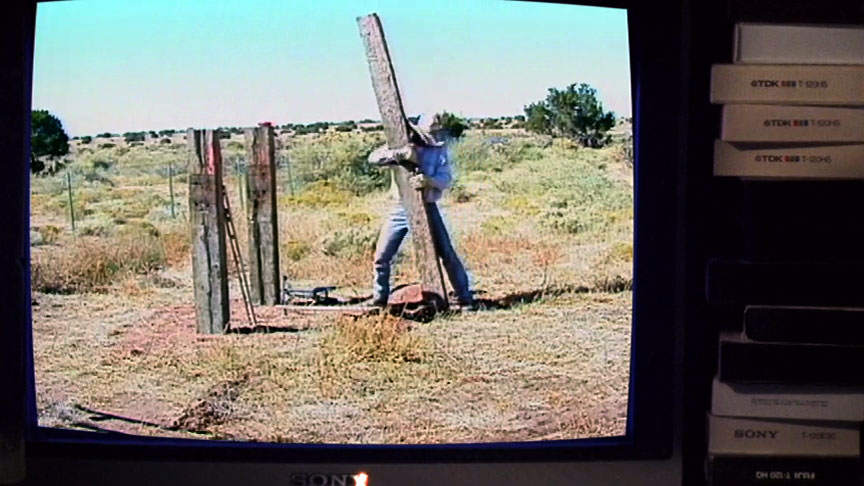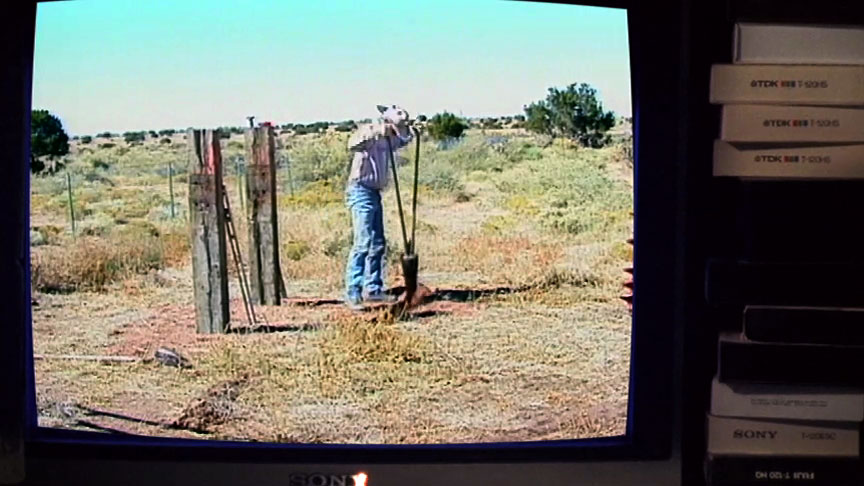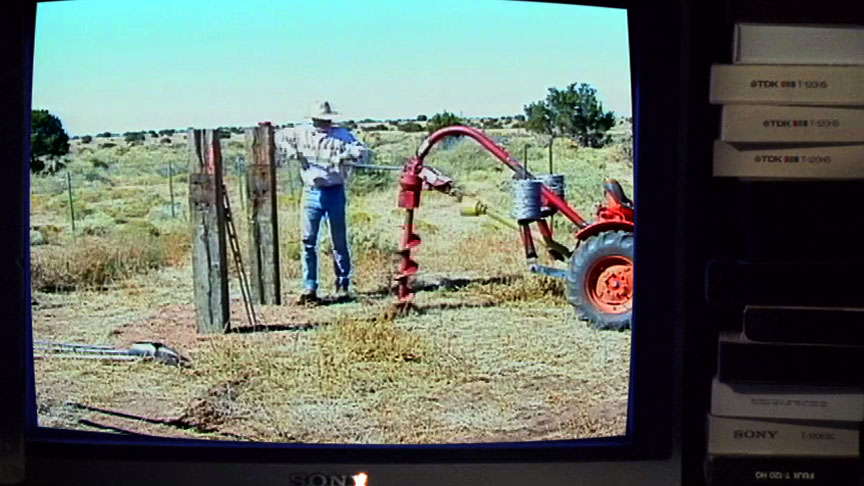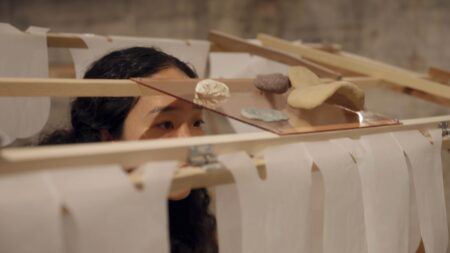Interview
“Setting a Good Corner”

Bruce Nauman watches Setting a Good Corner (2000) in his studio, New Mexico, 2000. Production still from the Art in the Twenty-First Century Season 1 episode, Identity. © Art21, Inc. 2001.
Bruce Nauman discusses the creation of his 2000 video piece Setting a Good Corner.
ART21: You’ve made a number of works on video that have a built-in continuous loop. Like the video work from 1967, The Artist is an Amazing Luminous Fountain—the text, spoken and onscreen, seems to repeat endlessly. This is a curious use of video, especially when compared to the way that most things seen on television are narrative driven.
NAUMAN: When I was making that piece, originally and then thinking about it later, people (a lot of people) were thinking about how to structure time. John Cage was making different kinds of ways of making music, and Merce [Cunningham] was structuring dance in different kinds of ways. And then [Andy] Warhol was making films that went on for a long period of time. And Steve Reich and La Monte Young were making music that was structured in a very different way. So, it was interesting for me to have a lot of ways to think about things.
And one of the things I liked about some of those people was that they thought of their works as, just, ongoing. And so, you could come and go, and the work was there. And so, there wasn’t a specific duration, so this thing can just repeat and repeat and repeat, and you don’t have to sit and watch the whole thing. You can watch for a while, leave and go have lunch or come back in a week, and it’s just going on. And I really liked that idea, of the thing just being there. The idea being there, so that it became almost like an object that was there, that you could go back and visit whenever you wanted to.
ART21: The video Setting a Good Corner seems to have a similar sense of duration, of something just being there and continuing along its own logic.
NAUMAN: This is a completely different situation where—again, even though this is a new work, or a newish work, it comes from some thoughts about earlier work—where you could control the length of the film or videotape or activity by having a specific job. You began when the job started; and when the job was over, the film was over. And that became a way of structuring it without having to think about it, other than deciding what the job was that you were going to call the work.
ART21: What was the specific job in Setting a Good Corner?
NAUMAN: In this case, we’re building a corner to stretch a fence and hang a gate. It had a real purpose on the ranch here; I needed to do this. But at the same time, it made a beautiful structure, and it also was one of these things: “Well, here’s the job and . . .”

Bruce Nauman watches Setting a Good Corner (2000) in his studio, New Mexico, 2000. Production still from the Art in the Twenty-First Century Season 1 episode, Identity. © Art21, Inc. 2001.
ART21: Is this where the text at the beginning and at the end of the video come in? The text at the beginning seems to describe what your activity is while the text at the end is more of a criticism of the project, of how well you made the corner.
NAUMAN: My partner—Bill Riggins at the end of tape—I showed him the tape, and he said, “Boy, you’re going to get a lot of criticism on that because people have a lot of different ways of doing those things.” And so, I put down some of the things that he said—about keeping your tools sharpened and not letting them lie on the ground, where they get hurt or get abused and dirty, and you can’t find them. And some thoughts about how his father used to do things—how these things, if you grow up with them, you learn them in one way.
ART21: Was it the activity that you thought would make a good video, or was it the way in which you framed the shot or the colors—that sort of thing?
NAUMAN: Well, I don’t know, and I wasn’t sure when I finished it if anybody would take it seriously. It turned out to be kind of interesting to watch. I gave a certain amount of thought to how I set up the shot and then after that . . . That’s not an uncommon way for artists to proceed. And then what makes the work interesting is if you choose the right questions. Then, as you proceed, the answers are what’s interesting. If you choose the wrong questions and you proceed, you still get a result, but it’s not interesting. And so, that’s in there. I think I learned some of that from Sol LeWitt, who does a lot of that. He builds a structure that you have to work with, and the work could come out different every time. But if you follow the structure, it’s interesting—sometimes beautiful and sometimes just interesting.

Bruce Nauman watches Setting a Good Corner (2000) in his studio, New Mexico, 2000. Production still from the Art in the Twenty-First Century Season 1 episode, Identity. © Art21, Inc. 2001.
ART21: How you determine the right questions in order to proceed?
NAUMAN: Well, that’s the art part, and that’s what you don’t know. That’s the hard part. And sometimes the question that you pose or the project that you start yourself turns into something else, you know. But at least it gets you started. And sometimes you finish, and you look at it and say, “I got a bad result. I don’t like what came out here.” And so, you have to start over or change it somehow. We were having dinner with the Tuttles one time, Richard and Mamie. And I had said that about Sol [LeWitt]—that he was interested in finding these questions and setting them up and seeing what happened. And Richard said, “Well, that’s the difference between us, because I already know the answers.” (LAUGHS) And so, I was driving home with Susan [Rothenberg] and I thought, “You know, I forgot to ask him what they were.” (LAUGHS) I was just so amazed.
ART21: So, when you were making the fence, even though you were filming it, you were mainly interested in doing the task well?
NAUMAN: Yeah. I mean, if the fence is going to last, it has to be done well. And so, you want to do a good job. Other cowboys and ranchers are going to come around, and they’ll see it and they’ll say, “Well, that . . . that’s a good one.” Or, “That’s not a good one.” It’s when you go to work at somebody else’s place, and the gates all work; or you have to get out of the truck, or off your horse, and drag them around and make a lot of extra work for yourself because nobody wants to spend the time to fix them up and make them work better. I have a lot of other things to do. So, if I’m going to do it, I’d like to get it right. So that, when I have to use it, it’s just there and it’s useful and useable, and I’m not wasting time with a lot of extra baling wire and stuff, patching it every once in a while.
ART21: Is there a meditative aspect to this kind of hard work?
NAUMAN: You have to adjust yourself to it because it’s hard work. And when I was digging that hole, the ground was extremely dry. The ground was very hard, like chipping limestone, almost, you know? And so, you adjust yourself to the task. And if you go out there and say, “Boy, I just hate doing this, and I got to get it done,” you’re probably not going to do a good job. And you might just forget, not even bother. But if you can find that spot—I suppose it’s like running; I used to be a swimmer and swam laps—and you just have to be there with what you’re doing. Your mind could actually go a lot of other places, but your body has to be there with what you’re doing. It’s a good discipline.
In the studio, I don’t do a lot of work that requires repetitive activity. I spend a lot of time looking and thinking and then try to find the most efficient way to get what I want, whether it’s making a drawing or a sculpture, or casting plaster or whatever. But part of the enjoyment I take in it is finding the most efficient way to do it—which doesn’t mean the corrections aren’t made. I like to have a feeling of the whole task before I start, even if it changes.

Bruce Nauman watches Setting a Good Corner (2000) in his studio, New Mexico, 2000. Production still from the Art in the Twenty-First Century Season 1 episode, Identity. © Art21, Inc. 2001.
ART21: Is there anything you’d want a viewer to take away from this work?
NAUMAN: It’s probably the part that I can’t say. It’s the part that makes it art and not a “how to do it” tape. If you’re an amateur artist, you can get it sometimes and not other times, and you can’t tell, and you can’t always do it over again. And the part about being a professional artist is that you can tell, and you can do it over again, even if you can’t say how you got there exactly. You’ve done it enough, and you know how to get there. And I don’t have any specific steps to take because I don’t start the same way every time. But there is a knowing when it’s enough and you can leave it alone. You could go on and maybe make some changes. They could ruin it, and they aren’t going to necessarily make it better. They’re just going to be different. And so, that’s what keeps me in the studio, the not-knowing part and always being surprised.
This interview was originally published on PBS.org in September 2001 and was republished on Art21.org in November 2011.



